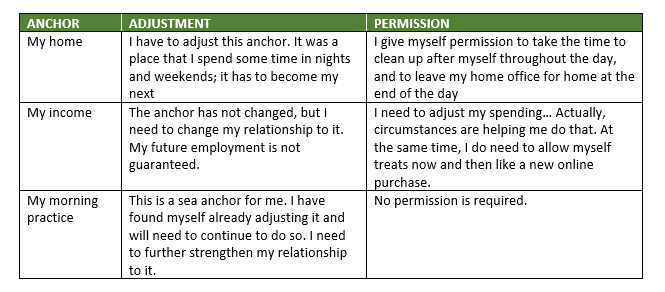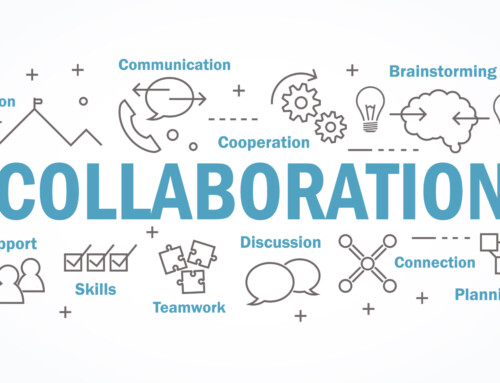For some change practitioners, working from home is the norm; for others it is a new, or at least unusual, experience. While this article is about working from home, it is not “tips and tricks.” Rather, it is more fundamentally how to prepare yourself, your loved ones and your colleagues to be able to focus once again on what is important. Until you have paid attention to adjusting your anchors, it will be difficult to maintain your focus on working from home.
Introduction to Anchors
We all have anchors, those things that provide us with a sense of stability and security day-to-day. Anchors are personal, and include beliefs, traditions, people, things, ways of doing and ways of being. Our anchors typically include some aspects of both our professional and our personal lives.
Much like the anchors that we think of, most of the time our anchors are working beneath the surface. But today many of us feel totally unmoored, adrift. Our routines have been upended, our family lives disrupted, and for many even our jobs put at risk, if not already lost. Now is the time to adjust your anchors, and to work with family, friends, colleagues, and even our organizations to help them adjust as well. This article provides general guidance on doing so. You can adapt this to work collaboratively with a team, a family, etc.
Create an Anchors Inventory
Before you think about adjusting your anchors you need to know what they are. This takes some time and reflection; remember, they tend to operate below the surface. Here are some things to think about.
- People: Who are the people in my life that provide me with a sense of stability and security? (e.g. a partner; a colleague; write down each person’s name)
- Beliefs: What are the beliefs in my life that provide me with a sense of stability and security? (e.g. I am strong; I know how to solve difficult challenges; spiritual and/or religious beliefs; write each one down)
- Traditions: What are the traditions in my life that provide me with a sense of stability and security? (e.g. Friday date night; Sunday dinner; write down each tradition)
- Things: What are the things in my life that provide me with a sense of stability and security? (e.g. my home; my bicycle; write down each thing)
- Ways of Doing: What are the ways of doing in my life that provide me with a sense of stability and security? (e.g. When I sit down at my desk in the morning, I clear out my email and plan the day; write each one down)
- Ways of Being: What are the ways of being in my life that provide me with a sense of stability and security? (e.g. I am a team player; write each one down)
Identify Your Sea Anchor(s)
Sea anchors are used by ships on the open water during major storms. They float under the surface and keep the ship facing into the turbulence so that it doesn’t capsize.
- Sea Anchor(s): Review your anchors inventory. Identify the anchor or anchors that you can count on to keep you facing into the turbulence that you are now experiencing. Most often sea anchors include key people in our lives, spiritual and/or religious beliefs, and/or things of special significance (e.g. family heirlooms).
Determine Adjustments to be Made
Now it is time to determine what anchors adjustments have to be made. Again, ask yourself the following questions.
- They’ve Been Changed: What anchors that I identified earlier have been changed as a result of the coronavirus pandemic? For each anchor you identify, Do I have to adjust this anchor, adjust to this anchor, or some of both? (e.g. Working from home instead of from office, and I have to adjust to this)
- Nothing’s Changed: What anchors that I identified earlier have not changed as a result of the coronavirus pandemic? For each anchor that you identify, Do I have to loosen my hold on this anchor, hold it more tightly, let it go completely, and/or leave it just the way it is? If changes are required, What changes do I have to make in my relationship to this anchor? (e.g. My relationship with my partner has not changed, and we need to work together to figure out how to both work from home every day)
- Review Adjustments: As a change practitioner, you know that people only have a limited capacity for change. For each of the changes that you have identified, ask yourself this question. Is it a good idea for me to make this change, or is it essential? If it is a good idea, take it off the list.
Give Yourself Permission
Sometimes the only thing that stands between us and change is… us. For example, I just completed anchors work with the CEO of an international company. She works hard at the office, including eating at her desk, so that she can get home to your young children for dinner. Now that her children are home full-time, it is important that she not “lock them out of the office” from early morning until late afternoon. She had to give herself permission to break up her day, including eating lunch with her children instead of at her desk.
- Permission: For each of the changes that are imperatives, ask yourself this. What permission, if any, do I need to give myself in order to make this change?
Prioritize and Adjust
Now it’s time to ask yourself, what is the most important anchor adjustment I can make now? Don’t tackle them all at once; that is a guarantee of overload. Don’t prioritize the full list; too much remains uncertain and it is likely your priorities will have to change over time. Take them one (or at best a few smaller ones) at a time. Adjust your anchors to support your work from home success.
Example





